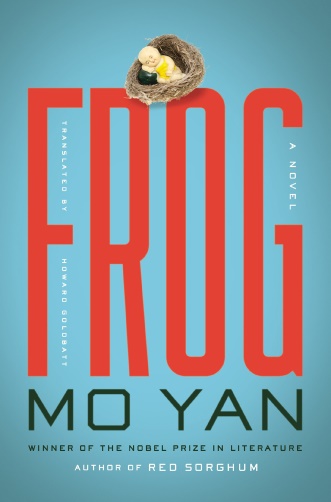Memo #347
By: Christopher Rea – chris.rea [at] ubc.ca

China’s One-Child Policy became, on October 29th, a two-child policy. The Policy was originally enacted to slow population growth, conserve resources, and ameliorate poverty; its actual results since 1979 have been well documented. One of its many unexpected effects was to inspire Mo Yan’s 2009 novel Frog (Wa).
The novel depicts Gugu, a superhuman obstetrician who, beginning in 1953, helps deliver over nine thousand babies in rural Shandong province. In 1979, she is charged with implementing the one child policy in her village. Most of the novel concerns how her zealous actions affect her community, and later her conscience. Once, she ferrets a family expecting a second child out of a secret passage beneath their house, prompting a bystander to sing a ditty about Chinese tunnel warfare during the Japanese occupation. In another case, she gives a man a vasectomy, inadvertently enabling him to become a rapist.
Gugu eventually marries a folk artist who molds clay dolls of babies, which aspiring mothers bring with their entreaties to the Fertility Goddess Temple. Childless herself, Gugu uses her husband’s creations as a talisman to atone for the thousands of lives she aborted and to invoke their reincarnation. This after she was one night overcome by a horde of frogs whose croaks sounded like “the souls of countless murdered infants were hurling accusations” at her.
She asks her nephew, nicknamed Tadpole:
Why does the word for frogs – wa – sound exactly like the word for babies – wa? …Why is the first sound a newborn baby makes an almost exact replica of a frog’s croak? … And why is the ancestor of humans called Nü wa? Like the ‘wa’ for frog. Doesn’t that prove that our earliest ancestor was a frog, and that we have evolved from her?
The novel is not just about the effects of state policy on human beings, but also about the creative impulse. Tadpole, who has been relating Gugu’s story in a series of letters, feels compelled to re-write it as a nine-act play, which appears in the book’s final section. Frog’s frogs, then, are not just amphibians with astounding reproductive capacity or symbols of a natural instinct to reproduce the species. They also exalt the fecundity of the artist’s imagination, even amidst state interventions into various forms of reproduction. Wa!
About the Author:
Christopher Rea is an Associate Professor of Modern Chinese Literature in the Department of Asian Studies, The University of British Columbia.
If you enjoyed this memo, subscribe to our e-newsletter for free and receive new memos weekly via email.
Links
- Christopher Rea, APM#182: “Mo Yan’s Nobel Prize in Literature: Interview with Dr. Christopher Rea”
- Brook Larmer, “The Long Shadow of China’s One-Child Policy,” The New York Times Magazine, November 6, 2015.
- “China allows all couples to have two children,” The Economist, October 29, 2015.
- Lanlan Du, “Abortion in Faulkner’s The Wild Palms and Mo Yan’s 蛙 (Frog),” in Mo Yan in Context: Nobel Laureate and Global Storyteller, edited by Angelica Duran and Yuhan Huang (West Lafayette: Purdue University Press, 2014): 63-76.
- Vanessa Fong, Only Hope: Coming of Age Under China’s One-Child Policy (Stanford University Press, 2004).
- Susan Greenhalgh, Just One Child: Science and Policy in Deng’s China (Berkeley: University of California Press, 2008).
- Peter Neville-Hadley, “The Birthing of a Nation,” The Wall Street Journal, March 19, 2015
Related Memos:
See our other memos on China.

